Abstract: This application note describes the hardware and software differences between the Dallas Semiconductor DS21Q44 and the DS21Q43A quad port framer devices. The DS21Q44 quad E1 framer, offers a broader feature set while retaining the original features of the DS21Q43A. As such, the designer must decide on what changes need to be made in software and hardware when migrating to the DS21Q44 from the DS21Q43A quad E1 framer. Any designer who is thinking of upgrading an existing design to use the DS21Q44 should read this application note. The application note contains detailed information for software migration such as: register location changes, how individual functions have changed from the DS21Q43A to the DS21Q44, and which new functions are available on the DS21Q44. It also covers migration for the hardware interface and covers new functions that are available in the DS21Q44. In the end, the designer should have enough information to easily migrate an existing design which uses the DS21Q43A to the DS21Q44 device.
Additional Functionality
Register Map Comparison
Note: Test Registers 1 and 2 are used only by the factory; these registers must be cleared (set to all 0s) on power-up initialization to ensure proper operation.
Device Identification (Section 6)
Expanded Elastic Stores Reset Functions (Section 6)
Interrupt on Change of Signaling State (Section 7 and 10)
DS0 Monitoring (Section 6 and 9)
Hardware Based Signaling (Section 6 and 10.2)
Signaling Freeze (Section 6 and 10.2)
Per Channel Loopback (Section 6 and 11.1)
* Alternate function for existing register set.
Per Channel Code (Idle) Insertion (Section 11.1 and 11.2)
Full HDLC and BOC Controller for FDL Support (Section 15)
Interleaved PCM Bus Operation (Section 16)
Register Bit Moves
Register Address Moves
Control Port Pins
Transmit Side Digital Pins
Receive Side Digital/JTAG Pins
Overview
This application note highlights the differences between the DS21Q44 and the DS21Q43A Quad E1 framers. The DS21Q44 is a superset of the DS21Q43A. The DS21Q44 is offered in a 3.3V version with 5V tolerant I/O. All of the original features of the DS21Q43A (except the loss-of-receive clock status bit) have been retained. Software created for the DS21Q43A is transferable to the DS21Q44 with minimal effort.Additional Functionality
| New Features | Data Sheet Section |
| Framer Mode Select (FMS) hardware pin provides DS21Q43A emulation mode | 1 |
| 8.192MHz clock synthesizer | 1, 3 |
| Expanded receive and transmit elastic store reset functions | 6 |
| Device identification register | 6 |
| Automatic RAI generation to ETS 300 011 specifications | 6 |
| RCL, RLOS, RRA, and RUA1 alarms now interrupt on change of state | 7 |
| Ability to monitor DS0 channel in both the transmit and receive paths | 9 |
Additional hardware signaling capability
|
10 |
| Per-channel loopback capability | 11 |
| Per-channel idle control | 11 |
HDLC controller
|
15 |
| 8Mbps interleaved PCM bus operation | 16 |
| JTAG support | 17 |
| 3.3V operation with 5V tolerant I/O | 19 |
Changes In Register Definitions
When implementing the new features of the DS21Q44, a priority was placed on preserving the DS21Q43A's register map to facilitate code migration from existing DS21Q43A designs. This section highlights register additions and differences found in the DS21Q44.Register Map Comparison
| Address | R/W | DS21Q44 Register | DS21Q43A Register |
| 00 | R | RBPV or Code Violation Count 1 | Same |
| 01 | R | BPV or Code Violation Count 2 | Same |
| 02 | R | CRC4 Error Count 1/FAS Error Count 1 | Same |
| 03 | R | CRC4 Error Count 2 | Same |
| 04 | R | E-Bit Count 1/FAS Error Count 2 | Same |
| 05 | R | E-Bit Count 2 | Same |
| 06 | R/W | Status 1 | Bit Difference |
| 07 | R/W | Status 2 | Bit Difference |
| 08 | R/W | Receive Information | Bit Difference |
| 09 | R/W | Test 2 | Not Used |
| 0A | µ | Not Used | Not Used |
| 0B | µ | Not Used | Not Used |
| 0C | µ | Not Used | Not Used |
| 0D | µ | Not Used | Not Used |
| 0E | µ | Not Used | Not Used |
| 0F | R | Device ID | Not Used |
| 10 | R/W | Receive Control 1 | Same |
| 11 | R/W | Receive Control 2 | Same |
| 12 | R/W | Transmit Control 1 | Same |
| 13 | R/W | Transmit Control 2 | Same |
| 14 | R/W | Common Control 1 | Same |
| 15 | R/W | Test 1 | Same |
| 16 | R/W | Interrupt Mask 1 | Bit Difference |
| 17 | R/W | Interrupt Mask 2 | Same |
| 18 | µ | Not Used | Same |
| 19 | µ | Not Used | Same |
| 1A | R/W | Common Control 2 | Bit Difference |
| 1B | R/W | Common Control 3 | Bit Difference |
| 1C | R/W | Transmit Sa Bit Control | Same |
| 1D | R/W | Common Control 6 | Same |
| 1E | R | Synchronizer Status | Same |
| 1F | R | Receive Nonalign Frame | Same |
| 20 | R/W | Transmit Align Frame | Same |
| 21 | R/W | Transmit Nonalign Frame | Same |
| 22 | R/W | Transmit Channel Blocking 1 | Same |
| 23 | R/W | Transmit Channel Blocking 2 | Same |
| 24 | R/W | Transmit Channel Blocking 3 | Same |
| 25 | R/W | Transmit Channel Blocking 4 | Same |
| 26 | R/W | Transmit Idle 1 | Same |
| 27 | R/W | Transmit Idle 2 | Same |
| 28 | R/W | Transmit Idle 3 | Same |
| 29 | R/W | Transmit Idle 4 | Same |
| 2A | R/W | Transmit Idle Definition | Same |
| 2B | R/W | Receive Channel Blocking 1 | Same |
| 2C | R/W | Receive Channel Blocking 2 | Same |
| 2D | R/W | Receive Channel Blocking 3 | Same |
| 2E | R/W | Receive Channel Blocking 4 | Same |
| 2F | R | Receive Align Frame | Same |
| 30 | R | Receive Signaling 1 | Same |
| 31 | R | Receive Signaling 2 | Same |
| 32 | R | Receive Signaling 3 | Same |
| 33 | R | Receive Signaling 4 | Same |
| 34 | R | Receive Signaling 5 | Same |
| 35 | R | Receive Signaling 6 | Same |
| 36 | R | Receive Signaling 7 | Same |
| 37 | R | Receive Signaling 8 | Same |
| 38 | R | Receive Signaling 9 | Same |
| 39 | R | Receive Signaling 10 | Same |
| 3A | R | Receive Signaling 11 | Same |
| 3B | R | Receive Signaling 12 | Same |
| 3C | R | Receive Signaling 13 | Same |
| 3D | R | Receive Signaling 14 | Same |
| 3E | R | Receive Signaling 15 | Same |
| 3F | R | Receive Signaling 16 | Same |
| 40 | R/W | Transmit Signaling 1 | Same |
| 41 | R/W | Transmit Signaling 2 | Same |
| 42 | R/W | Transmit Signaling 3 | Same |
| 43 | R/W | Transmit Signaling 4 | Same |
| 44 | R/W | Transmit Signaling 5 | Same |
| 45 | R/W | Transmit Signaling 6 | Same |
| 46 | R/W | Transmit Signaling 7 | Same |
| 47 | R/W | Transmit Signaling 8 | Same |
| 48 | R/W | Transmit Signaling 9 | Same |
| 49 | R/W | Transmit Signaling 10 | Same |
| 4A | R/W | Transmit Signaling 11 | Same |
| 4B | R/W | Transmit Signaling 12 | Same |
| 4C | R/W | Transmit Signaling 13 | Same |
| 4D | R/W | Transmit Signaling 14 | Same |
| 4E | R/W | Transmit Signaling 15 | Same |
| 4F | R/W | Transmit Signaling 16 | Same |
| 50 | R/W | Transmit Si Bits Align Frame | Same |
| 51 | R/W | Transmit Si Bits Non-Align Frame | Same |
| 52 | R/W | Transmit Remote Alarm Bits | Same |
| 53 | R/W | Transmit Sa4 Bits | Same |
| 54 | R/W | Transmit Sa5 Bits | Same |
| 55 | R/W | Transmit Sa6 Bits | Same |
| 56 | R/W | Transmit Sa7 Bits | Same |
| 57 | R/W | Transmit Sa8 Bits | Same |
| 58 | R | Receive Si bits Align Frame | Same |
| 59 | R | Receive Si bits Nonalign Frame | Same |
| 5A | R | Receive Remote Alarm Bits | Same |
| 5B | R | Receive Sa4 Bits | Same |
| 5C | R | Receive Sa5 Bits | Same |
| 5D | R | Receive Sa6 Bits | Same |
| 5E | R | Receive Sa7 Bits | Same |
| 5F | R | Receive Sa8 Bits | Same |
| 63 | R/W | Transmit Channel 4 | Not Used |
| 64 | R/W | Transmit Channel 5 | Not Used |
| 65 | R/W | Transmit Channel 6 | Not Used |
| 66 | R/W | Transmit Channel 7 | Not Used |
| 67 | R/W | Transmit Channel 8 | Not Used |
| 68 | R/W | Transmit Channel 9 | Not Used |
| 69 | R/W | Transmit Channel 10 | Not Used |
| 6A | R/W | Transmit Channel 11 | Not Used |
| 6B | R/W | Transmit Channel 12 | Not Used |
| 6C | R/W | Transmit Channel 13 | Not Used |
| 6D | R/W | Transmit Channel 14 | Not Used |
| 6E | R/W | Transmit Channel 15 | Not Used |
| 6F | R/W | Transmit Channel 16 | Not Used |
| 70 | R/W | Transmit Channel 17 | Not Used |
| 71 | R/W | Transmit Channel 18 | Not Used |
| 72 | R/W | Transmit Channel 19 | Not Used |
| 73 | R/W | Transmit Channel 20 | Not Used |
| 74 | R/W | Transmit Channel 21 | Not Used |
| 75 | R/W | Transmit Channel 22 | Not Used |
| 76 | R/W | Transmit Channel 23 | Not Used |
| 77 | R/W | Transmit Channel 24 | Not Used |
| 78 | R/W | Transmit Channel 25 | Not Used |
| 79 | R/W | Transmit Channel 26 | Not Used |
| 7A | R/W | Transmit Channel 27 | Not Used |
| 7B | R/W | Transmit Channel 28 | Not Used |
| 7C | R/W | Transmit Channel 29 | Not Used |
| 7D | R/W | Transmit Channel 30 | Not Used |
| 7E | R/W | Transmit Channel 31 | Not Used |
| 7F | R/W | Transmit Channel 32 | Not Used |
| 80 | R/W | Receive Channel 1 | Not Used |
| 81 | R/W | Receive Channel 2 | Not Used |
| 82 | R/W | Receive Channel 3 | Not Used |
| 83 | R/W | Receive Channel 4 | Not Used |
| 84 | R/W | Receive Channel 5 | Not Used |
| 85 | R/W | Receive Channel 6 | Not Used |
| 86 | R/W | Receive Channel 7 | Not Used |
| 87 | R/W | Receive Channel 8 | Not Used |
| 88 | R/W | Receive Channel 9 | Not Used |
| 89 | R/W | Receive Channel 10 | Not Used |
| 8A | R/W | Receive Channel 11 | Not Used |
| 8B | R/W | Receive Channel 12 | Not Used |
| 9C | R/W | Receive Channel 13 | Not Used |
| 8D | R/W | Receive Channel 14 | Not Used |
| 8E | R/W | Receive Channel 15 | Not Used |
| 8F | R/W | Receive Channel 16 | Not Used |
| 90 | R/W | Receive Channel 17 | Not Used |
| 91 | R/W | Receive Channel 18 | Not Used |
| 92 | R/W | Receive Channel 19 | Not Used |
| 93 | R/W | Receive Channel 20 | Not Used |
| 94 | R/W | Receive Channel 21 | Not Used |
| 95 | R/W | Receive Channel 22 | Not Used |
| 96 | R/W | Receive Channel 23 | Not Used |
| 97 | R/W | Receive Channel 24 | Not Used |
| 98 | R/W | Receive Channel 25 | Not Used |
| 99 | R/W | Receive Channel 26 | Not Used |
| 9A | R/W | Receive Channel 27 | Not Used |
| 9B | R/W | Receive Channel 28 | Not Used |
| 9C | R/W | Receive Channel 29 | Not Used |
| 9D | R/W | Receive Channel 30 | Not Used |
| 9E | R/W | Receive Channel 31 | Not Used |
| 9F | R/W | Receive Channel 32 | Not Used |
| A0 | R/W | Transmit Channel Control 1 | Not Used |
| A1 | R/W | Transmit Channel Control 2 | Not Used |
| A2 | R/W | Transmit Channel Control 3 | Not Used |
| A3 | R/W | Transmit Channel Control 4 | Not Used |
| A4 | R/W | Receive Channel Control 1 | Not Used |
| A5 | R/W | Receive Channel Control 2 | Not Used |
| A6 | R/W | Receive Channel Control 3 | Not Used |
| A7 | R/W | Receive Channel Control 4 | Not Used |
| A8 | R/W | Common Control 4 | Not Used |
| A9 | R | Transmit DS0 Monitor | Not Used |
| AA | R/W | Common Control 5 | Not Used |
| AB | R | Receive DS0 Monitor | Not Used |
| AC | R/W | Test 3 | Not Used |
| AD | µ | Not Used | Not Used |
| AE | µ | Not Used | Not Used |
| AF | µ | Not Used | Not Used |
| B0 | R/W | HDLC Control Register | Not Used |
| B1 | R/W | HDLC Status Register | Not Used |
| B2 | R/W | HDLC Interrupt Mask Register | Not Used |
| B3 | R/W | Receive HDLC Information Register | Not Used |
| B4 | R/W | Receive HDLC FIFO Register | Not Used |
| B5 | R/W | Interleave Bus Operation Register | Not Used |
| B6 | R/W | Transmit HDLC Information Register | Not Used |
| B7 | R/W | Transmit HDLC FIFO Register | Not Used |
| B8 | R/W | Receive HDLC DS0 Control Register 1 | Not Used |
| B9 | R/W | Receive HDLC DS0 Control Register 2 | Not Used |
| BA | R/W | Transmit HDLC DS0 Control Register 1 | Not Used |
| BB | R/W | Transmit HDLC DS0 Control Register 2 | Not Used |
| BC | µ | Not Used | Not Used |
| BD | µ | Not Used | Not Used |
| BE | µ | Not Used | Not Used |
| BF | µ | Not Used | Not Used |
Note: Test Registers 1 and 2 are used only by the factory; these registers must be cleared (set to all 0s) on power-up initialization to ensure proper operation.
New Feature Register Usage
Highlights specific registers containing bit locations related to new features. Each item can be found in the data sheet under the listed sections.Device Identification (Section 6)
| Register | Function |
| IDR | Device Identification Register |
Expanded Elastic Stores Reset Functions (Section 6)
| Register | Function |
| CCR5 | Common Control Register 5 |
| CCR6 | Common Control Register 6 |
Interrupt on Change of Signaling State (Section 7 and 10)
| Register | Function |
| SR1 | Status Register 2 (bits 7 and 5) |
| IMR1 | Interrupt Mask Register 2 (bits 7 and 5) |
DS0 Monitoring (Section 6 and 9)
| Register | Function |
| CCR4 | Common Control 4 (bits 4-0) |
| CCR5 | Common Control 5 (bits 4-0) |
| TDSOM | Transmit DS0 Monitor |
| RDSOM | Receive DS0 Monitor |
Hardware Based Signaling (Section 6 and 10.2)
| Register | Function |
| TCBR1-3 | Transmit Channel Block Registers 1-3 |
| CCR3 | Common Control 3 (bits 3, 2) |
Signaling Freeze (Section 6 and 10.2)
| Register | Function |
| CCR2 | Common Control 2 (bits 1, 0) |
Per Channel Loopback (Section 6 and 11.1)
| Register | Function |
| CCR3 | Common Control 3 (bit 5) |
| TIR1-3* | Transmit Idle Register 1-3 |
* Alternate function for existing register set.
Per Channel Code (Idle) Insertion (Section 11.1 and 11.2)
| Register | Function |
| TCC1-TCC4 | Transmit Channel Control 1-4 |
| TC1-TC32 | Transmit Channels Registers 1-32 |
| RCC1-RCC4 | Receive Channel Control 1-4 |
| RC1-RC32 | Receive Channels Registers 1-32 |
Full HDLC and BOC Controller for FDL Support (Section 15)
| Register | Function |
| HCR | HDLC Control Register |
| HSR | HDLC Status Register |
| HIMR | HDLC Interrupt Mask Register |
| RHIR | Receive HDLC Information Register |
| RHFR | Receive HDLC FIFO Register |
| RDC1 | Receive HDLC DS0 Control Register 1 |
| RDC2 | Receive HDLC DS0 Control Register 2 |
| THIR | Transmit HDLC Information Register |
| THFR | Transmit HDLC FIFO Register |
| TDC1 | Transmit HDLC DS0 Control Register 1 |
| TDC2 | Transmit HDLC DS0 Control Register 2 |
Interleaved PCM Bus Operation (Section 16)
| Register | Function |
| IBO | Interleave Bus Operation |
Bit Assignment Changes Within Existing Registers
Highlights bit locations in the DS21Q44 that have changed from the DS21Q43A.| Register | Bit # | DS21Q43A Symbol | DS21Q43A Description | DS21Q44A Symbol | DS21Q44A Description |
| CCR2 | 0 | N/A | Not Assigned | RFE | Receive Freeze Enable |
| CCR2 | 1 | N/A | Not Assigned | RFF | Receive Force Freeze |
| CCR3 | 0 | N/A | Not Assigned | RCLA | Receive Carrier Loss Alternate Criteria |
| CCR3 | 2 | N/A | Not Assigned | THSE | Transmit Side Hardware Signaling Insertion Enable |
| CCR3 | 3 | N/A | Not Assigned | RSRE | Receive Side Signaling Reinsertion Enable |
| CCR3 | 4 | ESR | Elastic Stores Reset | N/A | Not Assigned |
| ISR | 0 | F3SR2 | Status of Interrupt for SR2 in Framer 3 | F3HDLC | Framer 3 HDLC Controller Interrupt Request |
| ISR | 1 | F3SR1 | Status of Interrupt for SR1 in Framer 3 | F3SR | Framer 3 SR1 or SR2 Interrupt Request |
| ISR | 2 | F2SR2 | Status of Interrupt for SR2 in Framer 2 | F2HDLC | Framer 3 HDLC Controller Interrupt Request |
| ISR | 3 | F2SR1 | Status of Interrupt for SR1 in Framer 2 | F2SR | Framer 3 SR1 or SR2 Interrupt Request |
| ISR | 4 | F1SR2 | Status of Interrupt for SR2 in Framer 1 | F1HDLC | Framer 3 HDLC Controller Interrupt Request |
| ISR | 5 | F1SR1 | Status of Interrupt for SR1 in Framer 1 | F1SR | Framer 3 SR1 or SR2 Interrupt Request |
| ISR | 6 | F0SR2 | Status of Interrupt for SR2 in Framer 0 | F0HDLC | Framer 3 HDLC Controller Interrupt Request |
| ISR | 7 | F0SR1 | Status of Interrupt for SR1 in Framer 0 | F0SR | Framer 3 SR1 or SR2 Interrupt Request |
| RIR | 5 | LORC | Loss-of-Receive Clock | N/A | Not Assigned |
| SR1 | 5 | RSA1 | Receive Signaling All 1s | RSA1 | Receive Signaling All 1s/Signaling Change |
| SR1 | 7 | RSA0 | Receive Signaling All 0s | RSA0 | Receive Signaling All 0s/Signaling Change |
| IMR1 | 5 | RSA1 | Receive Signaling All 1s | RSA1 | Receive Signaling All 1s/Signaling Change |
| IMR1 | 7 | RSA0 | Receive Signaling All 0s | RSA0 | Receive Signaling All 0s/Signaling Change |
Register Bit Moves
| Function | DS21Q43A Location | DS21Q44 Location |
| ESR | CCR3.4 | Split into RESR (CCR6.1) and TESR (CCR6.0) |
Register Address Moves
| Function | DS21Q43A Location | DS21Q44 Location |
| ISR | Any address between 60h to 7Fh or between E0h and FFh | Any address from C0h to FFh |
Changes In Device Pinout
Package Types
The DS21Q43A and DS21Q44 are both offered in a 128 pin 20 x 14 x 1.4 mm TQFP. Values listed are for body dimensions.Device Pin Differences
Note: Brackets [ ] indicate pin function when the DS21Q44 is configured for emulation of the DS21Q43A (FMS = 1).Control Port Pins
| DS21Q44 | DS21Q43A | Function |
| A7 | VSS | Address Bus Bit 7 |
| FMS | VDD | Framer Mode Select |
| CLKSI [RLOS/LOTC3] | RLOS/LOTC3 | 8MHz Clock Reference Input [Receive Loss-of-Sync/Loss-of-Transmit Clock from Framer 3] |
| 8MCLK [RMSYNC3] | RMSYNC3 | 8MHz Clock [Receive Multiframe Sync from Framer 3] |
Transmit Side Digital Pins
| DS21Q44 | DS21Q43A | Function |
| TSIG0 [TCHCLK0] | TCHCLK0 | Transmit Signaling Input for Framer 0 [Transmit Channel Clock from Framer 0] |
| TSIG1 [TCHCLK1] | TCHCLK1 | Transmit Signaling Input for Framer 1 [Transmit Channel Clock from Framer 1] |
| TSIG2 [TCHCLK2] | TCHCLK2 | Transmit Signaling Input for Framer 2 [Transmit Channel Clock from Framer 2] |
| TSIG3 [TCHCLK3] | TCHCLK3 | Transmit Signaling Input for Framer 3 [Transmit Channel Clock from Framer 3] |
Receive Side Digital/JTAG Pins
| DS21Q44 | DS21Q43A | Function |
| JTRST* [RLOS/LOTC0] | RLOS/LOTC0 | JTAG Reset [Receive Loss-of-Sync/Loss-of-Transmit Clock from Framer 0] |
| JTCLK [RLOS/LOTC1] | RLOS/LOTC1 | JTAG Test Clock [Receive Loss-of-Sync/Loss-of-Transmit Clock from Framer 1] |
| JTDO [RLOS/LOTC2] | RLOS/LOTC2 | JTAG Test Data Output [Receive Loss-of-Sync/Loss-of-Transmit Clock from Framer 2] |
| CLKSI [RLOS/LOTC3] | RLOS/LOTC3 | 8MHz Clock [Receive Loss-of-Sync/Loss-of-Transmit Clock from Framer 3] |
| SPARE1 [RMSYNC0] | RMSYNC0 | Reserved. Must be left unconnected for normal operation [Receive Multiframe Sync from Framer 0] |
| JTMS [RMSYNC1] | RMSYNC1 | JTAG Test Mode Select [Receive Multiframe Sync from Framer 1] |
| JTDI [RMSYNC2] | RMSYNC2 | JTAG Test Data Input [Receive Multiframe Sync from Framer 2] |
| 8MCLK [RMSYNC3] | RMSYNC3 | MCLK Clock Reference Input [Receive Multiframe Sync from Framer 3] |
| RSIG0 [RCHCLK0] | RCHCLK0 | Receive Signaling Output from Framer 0 [Receive Channel Clock from Framer 0] |
| RSIG0 [RCHCLK1] | RCHCLK1 | Receive Signaling Output from Framer 1 [Receive Channel Clock from Framer 1] |
| RSIG0 [RCHCLK2] | RCHCLK2 | Receive Signaling Output from Framer 2 [Receive Channel Clock from Framer 2] |
| RSIG0 [RCHCLK3] | RCHCLK3 | Receive Signaling Output from Framer 3 [Receive Channel Clock from Framer 3] |
Operating the DS21Q44 in DS21Q43A Emulation Mode
The DS21Q44 is a superset of the DS21Q43A and can be configured to emulate the latter. This mode is enabled by tying the framer mode select (FMS) pin to VCC. Because the DS21Q44 supports an expanded register set, the A7 address pin was added to the device. Although the DS21Q44 does not require the functionality associated with the additional registers when in DS21Q43A emulation mode, the A7 pin must be used. This is necessary because the device does not automatically clear its register space on power-up. After the supplies are stable, each of four framers register space should be configured for operation by writing to all of the internal registers. This can be accomplished in a two-pass approach on each framer.- Clear framers register space by writing 00h to the addresses 00h through BFh.
- Program required registers to achieve desired operating mode.
 电子发烧友App
电子发烧友App










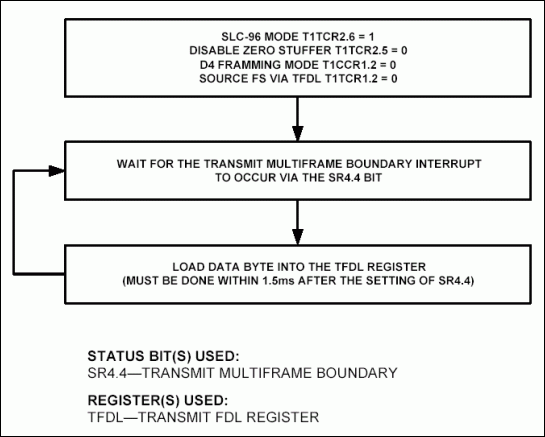
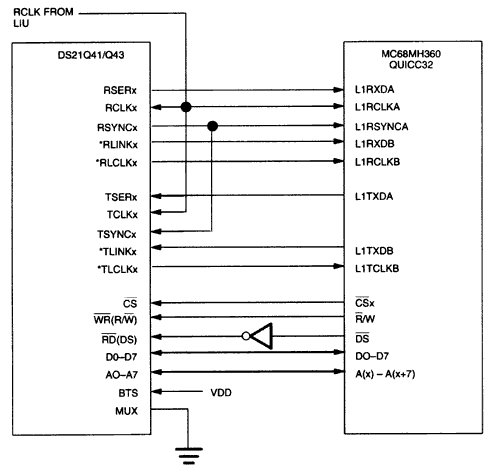
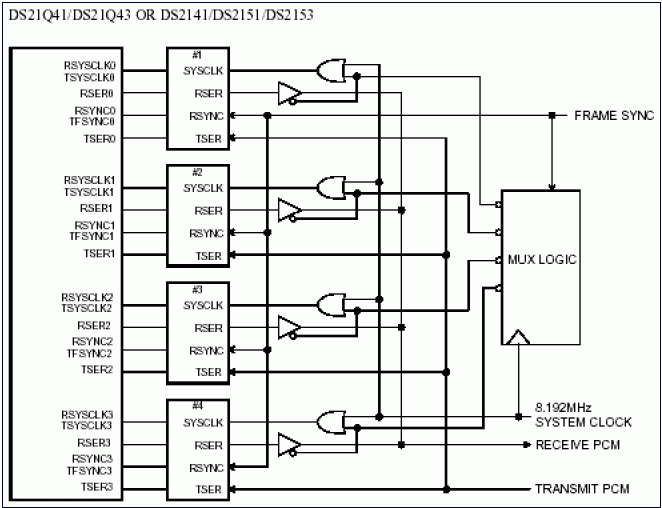
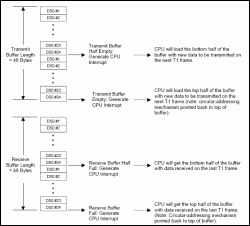
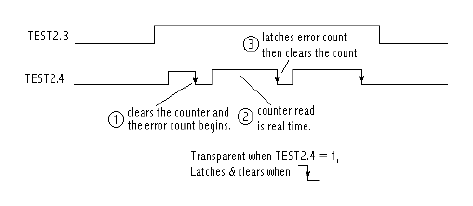
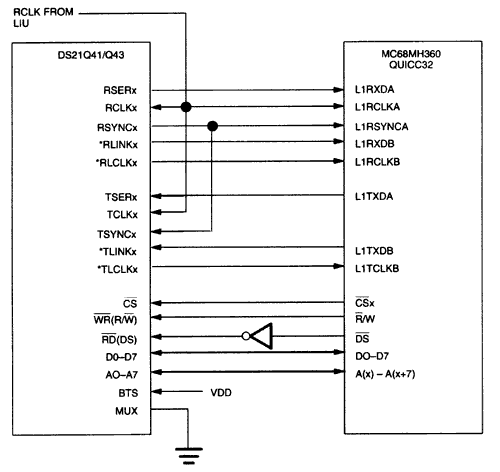
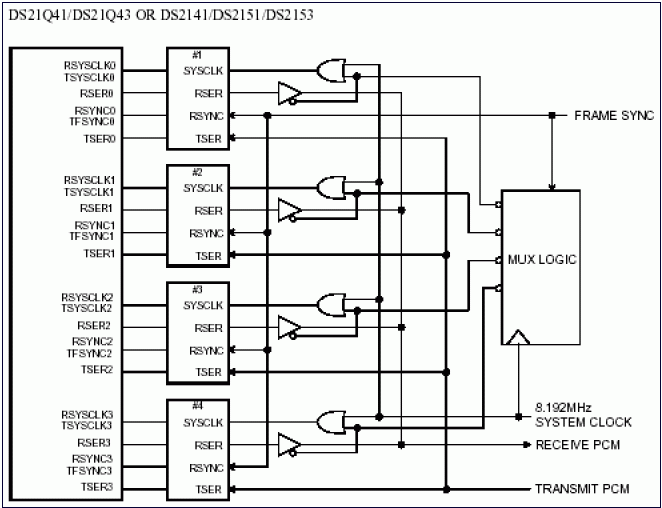
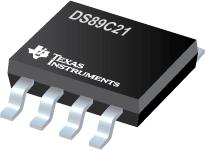











评论